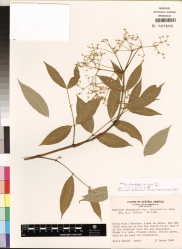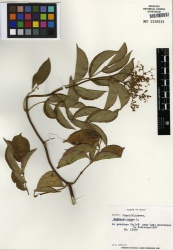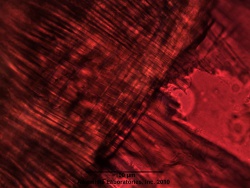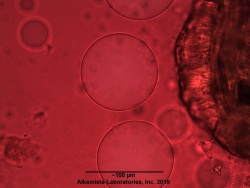Sambucus nigra (fruit)
(→add category divisions and wikipedia references) |
(add macro characteristics) |
||
| (11 intermediate revisions by 3 users not shown) | |||
| Line 1: | Line 1: | ||
| − | + | {{DISPLAYTITLE:''Sambucus nigra'' (fruit) }} {{askbox|herb=''Sambucus nigra''}} | |
| − | '' | + | =Nomenclature= |
| + | {{nomenclature | binomial=Sambucus nigra | ||
| + | |authority=L. | ||
| + | |family=Caprifoliaceae | ||
| + | |scn=European elder | ||
| + | |syn= | ||
| + | |ayurvedic= | ||
| + | |pinyin= | ||
| + | |aka=black elder; European elder | ||
| + | |notes=}} | ||
| − | + | =Botanical Voucher Specimen= | |
| − | + | {{Media2 |cat=Voucher | |
| − | + | | source=MOBOT, Tropicos.org | |
| + | | mainimage=Sambucus_nigra_Tropicos_71201_(S).jpg | ||
| + | | companyimage=TropicosLogo.gif | ||
| + | | companyURL=http://www.tropicos.org/Image/71201 | ||
| + | | reference=Tropicos.org. Missouri Botanical Garden. 26 Mar 2014 <http://www.tropicos.org/Image/71201> | ||
| − | + | | source2=MOBOT, Tropicos.org | |
| + | | image2=Sambucus_nigra_Tropicos_100000898_(S).jpg | ||
| + | | companyimage2=TropicosLogo.gif | ||
| + | | companyURL2=http://www.tropicos.org/Image/100000898 | ||
| + | | reference=Tropicos.org. Missouri Botanical Garden. 26 Mar 2014 <http://www.tropicos.org/Image/100000898> | ||
| − | + | | }} | |
| − | ''The | + | |
| − | + | =Organoleptic Characteristics= | |
| − | =Microscopic | + | {| border=1 |
| − | {{ | + | | |
| − | | | + | {{Organolepsy | source=United States Dispensatory (1918) |
| − | + | | description=The berries are nearly inodorous, but have a sweetish, acidulous taste, dependent on the presence of saccharine matter and malic acid.}} | |
| − | = | + | |} |
| − | = | + | |
| + | =Macroscopic Characteristics= | ||
| + | {| border=1 | ||
| + | | | ||
| + | {{Macroscopy | source=American Medicinal Plants of Commercial Importance (1930) | ||
| + | | description=[American] Elder [''Sambucus canadensis''] is a shrub attaining a height of 6 to 10 feet, its light gray, numerous stems being generally smooth and the younger ones containing a large white pith. The leaves are large and consist of 5 to 11 leaflets about 2 to 5 inches in length borne on short stalks. About June or July the flat-topped, fragrant clusters appear, composed of numerous, 5-lobed, wheel-shaped, creamy-white flowers. The clusters of edible fruits which follow are black or a very dark purple, small, round, shining, and juicy. | ||
| + | }} | ||
| + | |||
| + | {{Macroscopy | source=United States Dispensatory (1918) | ||
| + | | description=''Sambucus canadensis'', [American elder,] is a shrub from six to ten feet high, with a branching stem, covered with a rough gray bark, and containing a large spongy pith. The small branches and leaf-stalks are very smooth. The leaves are opposite, pinnate, sometimes bipinnate, and composed usually of five to nine oblong-oval, acuminate, smooth, shining, deep-green leaflets; the veins of the under surface are somewhat pubescent. The flowers are small, white, and disposed in loose cymes; the cream-colored corolla is wheel-shaped, with five stamens on the tube. The berries are small, globular, and deep purple when ripe. The shrubs grow in low, moist grounds, along fences, and on the borders of small streams, throughout the United States, from Canada to the Carolinas, and westward as far as Arizona and Texas. It flowers from May to July, and ripens its fruit early in autumn. | ||
| + | |||
| + | The common elder, ''Sambucus nigra'', of Europe, differs from the American most obviously in its size, the former approaching in height that of a small tree. The stem is much branched towards the top, and has a rough whitish bark. The leaves are narrower. The flowers are small, whitish and in five-parted cymes. The ovary consists of but three carpels, there being five cells in ''S. canadensis'' L. The berries are larger in the European elder, globular, and blackish-purple when ripe. }} | ||
| + | |} | ||
| + | |||
| + | =Microscopic Characteristics= | ||
| + | |||
| + | {{Media2 |cat=Microscopy | source=Elan M. Sudberg, Alkemist Laboratories | ||
| + | | companyimage= AP-LOGO-Laboratories Crop - Copy.jpg | ||
| + | | companyURL=http://www.alkemist.com | ||
| + | | mainimage=Elderberry.jpg | ||
| + | | caption1=Sclerenchyma fibers showing criss-crossed pattern observed at 400x with Acidified Chloral Hydrate Glycerol Solution. | ||
| + | | source2=Elan M. Sudberg, Alkemist Laboratories | ||
| + | | companyimage2= AP-LOGO-Laboratories Crop - Copy.jpg | ||
| + | | companyURL2=http://www.alkemist.com | ||
| + | | image2=Elderberry-1.jpg | ||
| + | | caption2=Scattered oil droplets observed at 400x with Acidified Chloral Hydrate Glycerol Solution. | ||
| + | | characteristics=cellular structures identified in this botanical specimen are the sclerenchyma fibers showing criss-crossed pattern and the scattered oil droplets when observed at 400x with Acidified Chloral Hydrate Glycerol Solution. | ||
| + | | reference=Botanical Pen-Portraits, Moll, W., 1923 | ||
| + | | }} | ||
| + | |||
| + | |||
| + | =High Performance Thin Layer Chromatographic Identification= | ||
| + | |||
| + | =Supplementary Information= | ||
| + | =Sources= | ||
| + | <references /> | ||
Latest revision as of 14:41, 24 June 2015
Contents |
Nomenclature
Sambucus nigra L. Caprifoliaceae
Standardized common name (English): European elder
Botanical Voucher Specimen
|
|
|
Organoleptic Characteristics
|
Macroscopic Characteristics
|
Microscopic Characteristics
 |
 |
|
|
|
High Performance Thin Layer Chromatographic Identification
Supplementary Information
Sources
- ↑ MOBOT, Tropicos.org http://www.tropicos.org/Image/71201
- ↑ MOBOT, Tropicos.org http://www.tropicos.org/Image/100000898
- ↑ United States Dispensatory (1918)
- ↑ American Medicinal Plants of Commercial Importance (1930)
- ↑ United States Dispensatory (1918)
- ↑ Elan M. Sudberg, Alkemist Laboratories http://www.alkemist.com
- ↑ Elan M. Sudberg, Alkemist Laboratories http://www.alkemist.com



